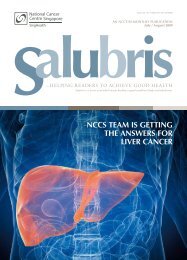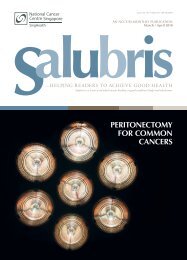Medical Professionals Version - National Cancer Centre Singapore
Medical Professionals Version - National Cancer Centre Singapore
Medical Professionals Version - National Cancer Centre Singapore
Create successful ePaper yourself
Turn your PDF publications into a flip-book with our unique Google optimized e-Paper software.
ADVANCES IN RADIOTHERAPY<br />
IN THE MANAGEMENT OF<br />
EARLY PROSTATE CANCER<br />
PAGE C1<br />
Under The Microscope<br />
SALUBRIS<br />
July / August 2009<br />
INTRODUCTION<br />
Prostate cancer is a cancer whose incidence has been<br />
steadily increasing over the last 35 years. It is typically<br />
found in men older than 50 years but its incidence<br />
varies greatly around the world. In <strong>Singapore</strong>, it is<br />
now the 3rd most common male cancer.<br />
By Dr Terence Tan<br />
Sr Consultant Radiation Oncologist,<br />
Dept of Radiation Oncology,<br />
NCCS<br />
Early prostate cancer refers to cancer confined to the prostate (stage I & II) and these may be managed<br />
by surgery, radiotherapy or active surveillance. Locally advanced prostate cancer on the other hand is<br />
best treated by a combination of androgen suppression therapy and radiotherapy.<br />
This article looks at advances in the use of radiotherapy in the management of localised prostate cancer.<br />
DOSE<br />
It is now generally accepted that there is a doseresponse<br />
curve for prostate above the conventionally<br />
given 66 Gy. Studies from the Memorial Sloan-<br />
Kettering <strong>Cancer</strong> Center and M.D. Anderson <strong>Cancer</strong><br />
Center have shown that patients have improved<br />
relapse-free survivals when given doses above 70<br />
Gy. While studies into the delivery of even higher<br />
doses are on-going, the current recommendation is<br />
for doses of at least 74 Gy (minimum tumour dose)<br />
to be delivered.<br />
Dose escalation studies began in the era of 3-D<br />
conformal radiotherapy and it was noted that<br />
while increases in the total dose delivered to the<br />
tumour improved disease-free survival, rectal and<br />
bladder morbidity rates also increased. That was<br />
until the advent of Intensity Modulated Radiation<br />
Therapy (IMRT).<br />
IMRT<br />
Intensity modulated radiotherapy is a very sophisticated form of radiation where<br />
the cross-sectional exposure of each treatment beam is not uniform as in the<br />
past but is varied by computer control (intensity-modulated) such that parts of<br />
the beam passing through sensitive normal structures have reduced exposure<br />
rates while parts which pass through tumour and not normal tissues have higher<br />
exposure rates.<br />
In this way, when a number of such treatment beams are arrayed around the<br />
patient, the high-dose treatment volume can be made to envelope the tumour<br />
target volume very conformably while sparing the surrounding normal tissues to<br />
a degree even greater than the previously used 3-D conformal techniques.<br />
Even within the treatment volume, it is possible to vary the dose (dose-paint),<br />
giving for example a radical dose to the tumour proper while delivering a lesser<br />
prophylactic dose to the draining lymphatics, all within the same treatment<br />
session. The availability of this technology has made dose escalation to very high<br />
levels possible with even less side-effects. IMRT has been in use at the <strong>National</strong><br />
<strong>Cancer</strong> <strong>Centre</strong> <strong>Singapore</strong> (NCCS) since 2001.<br />
Continued on page C2.

















